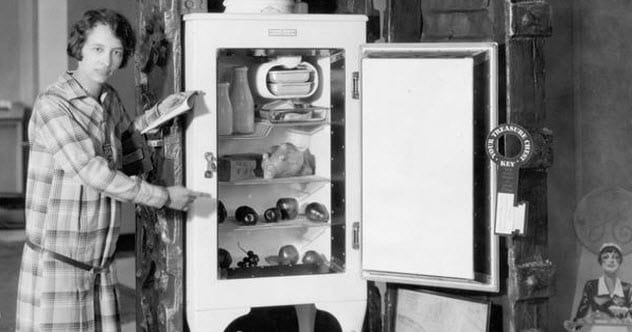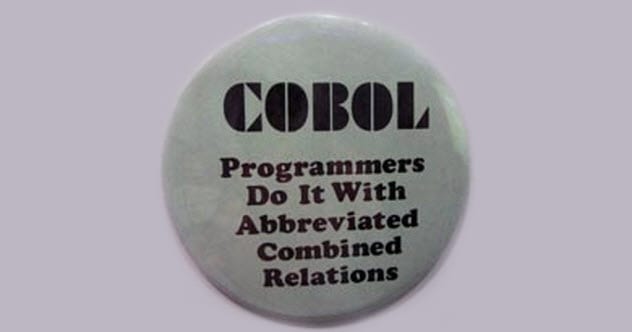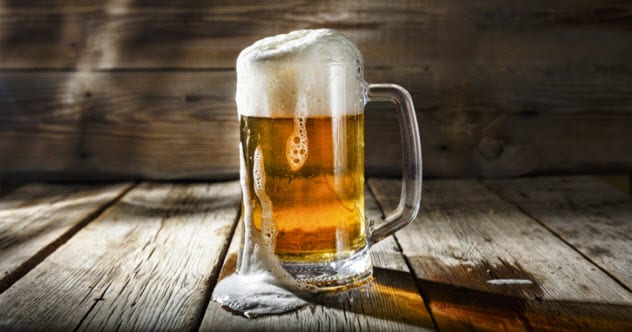 Weird Stuff
Weird Stuff  Weird Stuff
Weird Stuff  Mysteries
Mysteries 10 Tragic Disappearances and Deaths in Joshua Tree National Park
 History
History 10 Ways Childhood Really Sucked in the Old West
 Music
Music 10 Name Origins of Famous Bands from the 1990s
 Religion
Religion 10 Biggest Turnarounds by the Catholic Church
 Weird Stuff
Weird Stuff 10 Unbelievable Times Laws Had Unintended Consequences
 Humans
Humans Ten Historic Women Who Deserve Way More Credit Than They Got
 Movies and TV
Movies and TV 10 Films That Spawned Major Lawsuits
 History
History Ten Times Towns Were Wiped Off the Face of the Earth
 Creepy
Creepy 10 of the Most Disturbingly Haunted Public Houses in the UK
 Weird Stuff
Weird Stuff 10 Niche Subcultures That Are More Popular Than You Might Think
 Mysteries
Mysteries 10 Tragic Disappearances and Deaths in Joshua Tree National Park
 History
History 10 Ways Childhood Really Sucked in the Old West
Who's Behind Listverse?

Jamie Frater
Head Editor
Jamie founded Listverse due to an insatiable desire to share fascinating, obscure, and bizarre facts. He has been a guest speaker on numerous national radio and television stations and is a five time published author.
More About Us Music
Music 10 Name Origins of Famous Bands from the 1990s
 Religion
Religion 10 Biggest Turnarounds by the Catholic Church
 Weird Stuff
Weird Stuff 10 Unbelievable Times Laws Had Unintended Consequences
 Humans
Humans Ten Historic Women Who Deserve Way More Credit Than They Got
 Movies and TV
Movies and TV 10 Films That Spawned Major Lawsuits
 History
History Ten Times Towns Were Wiped Off the Face of the Earth
 Creepy
Creepy 10 of the Most Disturbingly Haunted Public Houses in the UK
10 Extremely Important Things That Were Invented By Women
Throughout history, most of the world’s leaders, philosophers, and inventors have been men. Yet many things we know and love today were actually created by women.
Whether these items are fun or absolutely pivotal to our daily lives, inventions by women have contributed a lot to our way of living and helped to shape the course of human history. It’s awe-inspiring to sit back and think of the collective conscious thought that has been the totality of humanity and the contributions certain individuals have made to it.
Here are 10 extremely important things that were invented by women.
10 The Electric Refrigerator

For ages before the advent of the refrigerator, iceboxes were the customary way to keep foods cold and fresh at the appropriate temperature and away from microscopic life that might taint the food and make us sick. Iceboxes were shelving units into which snow was packed during the winter months. This required the grueling task of repeatedly gathering ice to keep your food cold.
But that all changed when Florence Parpart came onto the scene. Outside of some US government census data, we know little about Parpart. But we do have the patent records that show that she invented the refrigerator.
What was missing?
Electricity. She needed to design a way to effectively run an electric circuit through the refrigerator to keep it cool. And what could keep it cool? Gas.
Refrigerators work by turning various liquids into gases, such as Freon. Upon expanding into their gaseous form, they draw in heat from the outside and away from the food. The trick to having this work is making it a circuit of absorption and expansion of the gas in different compartments so that the liquid isn’t all absorbed and needs to be refilled again.
These liquids are called refrigerants. So next time you reach for that piece of Saint-Andre cheese, you can thank Florence Parpart for her pivotal contribution to our world.[1]
9 The First Treatment For Leprosy
 Leprosy causes discoloration of the skin in some places and has been a disease mentioned since the days of the original Holy Bible. It has plagued humanity for almost the entirety of its existence. It infects the skin, the brain, the mucous membranes, the eyes, the mouth, and the nose.
Leprosy causes discoloration of the skin in some places and has been a disease mentioned since the days of the original Holy Bible. It has plagued humanity for almost the entirety of its existence. It infects the skin, the brain, the mucous membranes, the eyes, the mouth, and the nose.
Leprosy is a tremendously difficult disease to treat. But some outbreaks have been stopped, and the disease has been contained for many people.
We can thank a woman named Alice Ball, who figured out the administration method for what would become the first effective treatment for leprosy. Chaulmoogra oil, an extract from the seeds of a tree, was only marginally effective at the time, but it could not be eaten without causing nausea and vomiting. Upon injection, the oil wouldn’t properly spread throughout the skin.
Instead, it would just lie in patches beneath the surface and not get to the entirety of the disease. This was highly ineffective. As a chemist, Ball came up with a way to isolate the fatty acids which made the chaulmoogra oil unable to properly spread. She created the first injectable version that did the job.[2]
8 Windshield Wipers

No matter where it’s raining, windshield wipers have helped drivers to stay safe and see the road ahead of them clearly. This is all thanks to their invention by Mary Anderson. On November 10, 1903, Anderson filed the patent for a device that reached to the outside windows from inside the car and cleaned the glass in rain or snow.
It came to her in winter 1902 while watching trolley cars roll by. She realized that drivers had to stick their heads out of their car windows in snowy weather to be safe on the roads. And thus the windshield wiper idea was born.[3]
The patent was issued, but not all was rosy for Mary Anderson. She tried to sell her idea to companies, particularly a Canadian firm. But she was told that her invention was useless. In fact, she never saw a dime from her creation.
She was issued a 17-year patent in 1903. It expired in 1920. However, when the US automobile industry took off, windshield wipers became a staple for drivers around the world as more people drove cars.
7 The One-Handed Syringe

The history of medical inventions has been rife with trial and error, which meant absolute horror or salvation in the life or death of a patient in need of medical attention. Over the centuries, many struggled to come up with the syringe we know and love today, but nobody could get it quite right.[4]
Then, on February 12, 1896, Letitia Mumford Geer filed the first application for a patent on the one-handed syringe. Technically, many other syringes came before this, but none were as useful as the one-handed model. It was easily operable by both medical staff and patients, including diabetics who needed to self-administer insulin.
Although Geer’s invention has been modified to become the disposable syringe of today, her model helped to shape the future in how we get things into and out of our bodies.
6 COBOL

Common Business Oriented Language (COBOL) is a computer language which grew out of the 1959 Conference on Data Systems Languages. It was invented by Grace Hopper, a US Navy admiral who also developed a slew of information technologies for computers.[5]
Hopper was instrumental in writing COBOL, which was put in motion by the Department of Defense and private firms with a very specific intention: universality. The goal was to make a computer language that could be used on various hardware systems that typically communicated in different languages. COBOL became the solution, a language that was easily transportable between manufacturers. It was also quite easy for computers to read.
Although COBOL was mostly phased out by the 1990s, it initially served as the language that allowed computers from different manufacturers to speak to one another with ease. COBOL served as a backbone of computing systems for decades until it was phased out for better, more updated models.
5 Wi-Fi

Actress Hedy Lamarr was considered as beautiful as she was intelligent. She had come to America to escape Nazi Germany and build a new life. Lamarr was destined for stardom and would share the stage with some of Hollywood’s biggest names and talent of the day.
But before her stardom in the States, Lamarr had worked with a composer to design a way for devices to reduce the signal issues in telecommunications during World War II. This design became fundamental in a lot of technologies, including Wi-Fi.
Lamarr’s frequency-hopping technology was given away for free to combat the Nazis. However, over the years, she watched it become the basis for cellular phone technology and plenty of other things. Sadly, she never received any money for her invention even though she held the patent. But her efforts likely saved many lives during the war.[6]
She finally got some recognition for her invention about 50 years down the road with an award. Lamarr lived out the rest of her days in the US and died in Orlando at age 86.
4 Chocolate Chip Cookies

Every person enjoying a chocolate chip cookie can thank one person, Ruth Graves Wakefield, for putting it together one day. The best part is that it all came about by accident.
One day in 1930, Ruth wanted to whip up a batch of chocolate butter drop cookies. She went to place baker’s chocolate into the cookies she had assembled when she realized she was missing this key ingredient. She then took a regular chocolate bar, cut it into pieces, placed it into the cookies, and hoped that the chocolate would spread throughout the cookies equally when they baked.[7]
She was absolutely wrong. But the cookies turned out to be a hit anyway. She was at the Toll House Inn and was a lecturer on fine food preparations. With an immediate audience who loved them, Toll House chocolate chip cookies were born. Enjoy!
3 Computer Software

Computer software was invented by a woman. Yes. All of it. Ada Lovelace was an Englishwoman who was born Augusta Ada Byron, the daughter of the poet Lord Byron. So it’s safe to say that she wasn’t exactly born into poverty and had the fortunate opportunity of a private education at her fingertips.
Later, she came up with a way that the Analytical Engine (the first computer) could be taught to calculate certain types of numbers. And thus computer software was born.
The first known computer language was called “Ada” after Ada Lovelace, and it’s still in use in many respects today. While it has been adapted, the fundamentals of Ada are still there and are in use in some programs today.[8]
2 Electric Water Heater

Within the next few days, chances are good that you’ll take a nice, enjoyable, hot shower. The technology that made it all possible was invented in 1917 when Ida Forbes was officially awarded the patent for the first electric water heater. To this day, she’s still being thanked in advertisements and even on products with her original design on them. That’s how important hot showers are to us.
Electric water heaters went through years of manufacturing to become the staple product we know today—from small, portable models to midsize closet units to massive models for larger accommodations. In most developed nations, almost all water that isn’t used for cooking is heated with a descendant of one of these units.
Did you just get finished with a daily workout, or perhaps you’re going out to grab some sushi and are in need of a shower? Thank Ida Forbes for the invention that helped make sure that shower wasn’t a cold one.[9]
1 Beer
 Beer has had a long, strange, and interesting history. But whether you prefer an IPA or a deliciously dark stout, the long process that perfected that beer in your cup was originally carried out by women.[10]
Beer has had a long, strange, and interesting history. But whether you prefer an IPA or a deliciously dark stout, the long process that perfected that beer in your cup was originally carried out by women.[10]
While it’s presumed that beer was “invented” by accident when attempts to make bread went awry over 10,000 years ago, beers that were intentionally made came about in the Fertile Crescent approximately 7,000–9,000 years ago.
Historians have pointed out that all of the beer-making and crafting was likely handled by women. In fact, it was only when medieval and modern Christianity came about that beer-making was done by men, usually monks who decided to live on beer alone for months.
Nevertheless, throughout the ages, the recipes were crafted and perfected by anonymous women who painstakingly created the best beer they could for their communities. This makes a bit of sense considering that labor was divided among the sexes for centuries in many cultures.
So pour yourself a fine EPA, enjoy it, and imagine the countless hours of effort and entrepreneurship which have gone into crafting that perfect drink just for you.
I like to write about dark stuff, history, and this is a fun little one about really cool things that were invented throughout the ages by women. Trying to lighten things up before getting back to serial killers, hence Diogenes, this, and books.
Read more fascinating facts about incredible women on 10 Forgotten Women Who Secretly Ruled The World and 10 Incredible Women Forgotten By History.








